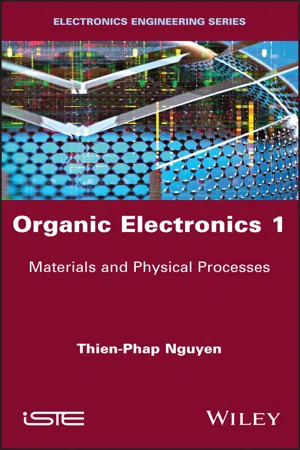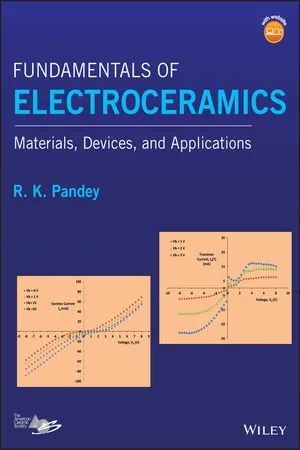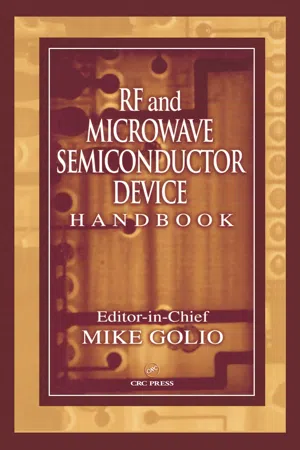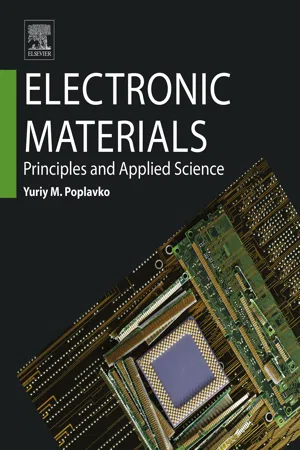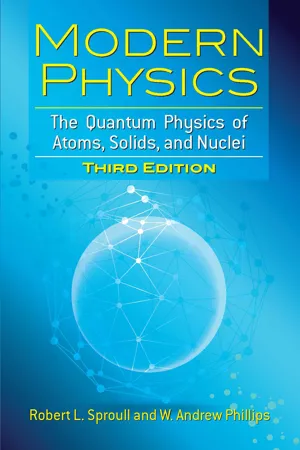Technology & Engineering
n type Semiconductor
An n-type semiconductor is a type of material that has been doped with elements that provide an excess of negative charge carriers, typically electrons. This results in the semiconductor having an overall negative charge. N-type semiconductors are commonly used in electronic devices and integrated circuits, where they play a crucial role in the functioning of transistors and other components.
Written by Perlego with AI-assistance
Related key terms
Related key terms
1 of 4
Related key terms
1 of 3
9 Key excerpts on "n type Semiconductor"
- eBook - ePub
Organic Electronics 1
Materials and Physical Processes
- Thien-Phap Nguyen(Author)
- 2021(Publication Date)
- Wiley-ISTE(Publisher)
1 Semiconductor TheoryThis chapter provides a brief overview of the basic concepts of semiconductor theory with regard to particular physical characteristics that allowed the creation of electronic components that would revolutionize various technologies starting in the middle of the 20th Century. We will now describe the operation of P–N junctions, which are the essential components for the creation of electronic devices. This basic knowledge will then allow us to address physical processes in organic materials and then to understand the operation and use of devices based on new organic semiconductors.1.1. Introduction
In electronics, the basic materials are semiconductors (SCs). They differ from metals in their dependence on the temperature of their electric characteristics. Essentially, when the temperature increases, the resistivity of metals increases, while the resistivity of SCs decreases. The theoretical contributions made by quantum mechanics allowed the electrical properties of SCs to be studied and explained based on the theory of energy bands. Unlike metals, in which the charge carriers are electrons, SCs can also carry positive charges, known as holes, that contribute to the electrical conductivity of these materials. The concentration of the carriers can also be changed by “doping”, that is, the incorporation of the selected impurities in a determined quantity. This process not only allows the conductivity of the SC to be changed, but also favors the transport of one type of charge carrier at the expense of the other. An SC is characterized as N-type if the majority of the carriers are electrons and as P-type if the majority of the carriers are holes.The combination of an N-type and P-type SC is a P–N junction, which is the fundamental element of all traditional electronic components. The assembly of these elements, prepared with other materials, makes it possible to create components that perform special functions, and the design of the circuits with these components leads to multiple applications of various different types. - eBook - ePub
Modern Manufacturing Technology
Spotlight on Future
- Jitendra Kumar Katiyar, Ranjeet Kumar Sahu(Authors)
- 2021(Publication Date)
- CRC Press(Publisher)
4 Ultrafine Electronic Devices Manufacturing TechniquesDOI: 10.1201/9781003203162-44.1 Semiconductor
Semiconductors are one of the electronic materials that behave in between conductors and insulators. They have higher electrical conductivity than insulators but lower conductivity than conductors at room temperature. The energy gap (band gap) of semiconductors lies in between 0 and 4 eV due to which they have moderate conductivity and carrier density at room temperature. They strongly absorb light, i.e., near IR and visible regions, and having energies above the energy gap. The semiconductor materials are Si, Ge, Ga, As, In, Sb, Se, etc., in which Si and Ge lie in the IV column of the periodic table known as elemental semiconductors. Further, Zn, Cd, Ga, In, As, Sb, Se and Te lie in II, III, V and VI columns of the periodic table, respectively. The combination of II and VI, III and V column atoms gives the binary compound, i.e., known as compound semiconductors. There are also ternary (GaAsP) and quaternary (InGaAsP) compounds that are exited in semiconductors (Swaminathan, 2017 ; Groover, 2018 ). It is important to note that insulators at higher temperatures behave like semiconductors.4.1.1 Semiconductor Doping
Doping in semiconductors is very important to make it electrically conductive. This can be achieved by the addition of elements, known as impurities. This process is known as doping. For example, if arsenic is added to silicon as an impurity, then it behaves like a conductor. This is decided through the valence of electrons. It is noted that one valence electron remains in arsenic after bonding with silicon. This left electron results in the flow of current. Further, if more arsenic atoms are added, then a large number of free electrons are generated, resulting in low resistance due to which free flow of current. Interestingly, if a few boron atoms are added with arsenic, then a few electrons are absorbed by boron, causing high resistance due to which low flow of current. Therefore, it can be said that controlling dopants can control any resistance. Using diffusion and ion implantation techniques can carry the doping in the semiconductor. By using these techniques, n-type or p-type semiconductors are manufactured (Swaminathan, 2017 - eBook - ePub
Fundamentals of Electroceramics
Materials, Devices, and Applications
- R. K. Pandey(Author)
- 2018(Publication Date)
- Wiley-American Ceramic Society(Publisher)
7 Elements of A Semiconductor Chapter Menu 7.1 Introduction 7.2 Nature of Electrical Conduction in Semiconductors 7.3 Energy Bands in Semiconductors 7.4 Origin of Holes and n‐ and p‐Type Conduction 7.5 Important Concepts of Semiconductor Materials 7.6 Experimental Determination of Semiconductor Properties Problems Science is not only a discipline of reason but, also, one of romance and passion. Stephen Hawking 7.1 Introduction Semiconductor materials dominate modern electronics and microelectronics technology and have greatly influenced our civilization. Their impact is second to none in each and every aspect of our lives. There is hardly any device that we use in our daily life that has remained immune from the impact of semiconductors be it a child's simple toy or a spaceship exploring the universe in quest of knowledge. We all are familiar with the words diode, transistors, electronic switches, amplifiers, etc. They are ubiquitous in our lives, and it is hard to imagine how the modern society could even function without these wonder devices. We use a block diagram shown in Figure 7.1 to introduce our readers to the essential elements of semiconductor materials and devices. It is nevertheless just a brief representation of the field and, by no means, can the vastness of semiconductor technology be encompassed in one single figure. We have tried to do justice to this subject in this chapter particularly in describing the theoretical aspect of the semiconductor phenomenon relevant to the understanding of the nature and properties of electroceramic semiconductors that we will cover in the next chapter - eBook - ePub
- Geoff Lewis(Author)
- 2013(Publication Date)
- Routledge(Publisher)
intrinsically pure tetravalent semiconductor elements (I type material) with trivalent or pentavalent impurities in a precisely controlled way, pseudo-semi-conduction can be produced by the careful combination of the Group III (trivalent) and Group V (pentavalent) elements to produce a new class of device with even more useful characteristics. By adding pentavalent impurity atoms to I type material, additional electrons are donated to the crystal structure. This forms an n type Semiconductor material in which electrons form the majority current carriers.In a similar way, the addition of trivalent impurities leaves spaces or holes in the crystal structure which represent energy levels where electrons could exist. This P type material thus has the positive charges of the holes as majority carriers. A hole therefore has an equal but opposite polarity charge to that of an electron. In both P and N type materials there will always be some thermally generated charges of the opposite polarity and these are known as minority carriers.In certain applications, the P and N type impurity layers may be doped to a relatively higher or lower level than normal. By convention, these regions would be indicated as P+ or N+ ; or P– or N–, respectively.If a surface of a mono-crystalline P type material is heated to about 1100°C and exposed long enough to a gaseous atmosphere of N type impurity, the surface will be converted into N type. Therefore, somewhere below the surface, there will exist a junction on an atomic scale, between the P and N type materials. Holes and electrons will migrate across this junction to produce an electric field described as the barrier potential. When this reaches some particular level (about lOOmV for Ge and 600 mV for Si), the region becomes depleted of free current carriers to produce a barrier or depletion region as indicated in Fig. 32.1 . If an external voltage greater than the barrier potential, is now applied to this junction with a positive polarity on the P region (forward bias), current will flow through the junction and in the external circuit. If the applied voltage is reversed, the barrier potential is reinforced and very little current flows (reverse bias). This current would in fact fall to zero if it were not for the thermally generated hole-electron pairs that act as minority carriers. Operated in this way, the PN junction thus has diode characteristics which, in many cases, can conveniently be considered simply as a piecewise - eBook - ePub
Semiconductor Basics
A Qualitative, Non-mathematical Explanation of How Semiconductors Work and How They are Used
- George Domingo(Author)
- 2020(Publication Date)
- Wiley(Publisher)
Eq. (3.1) . That gives you an idea of how much I can change the properties of semiconductors.I have just described what an n‐type semiconductor is, n‐type because, at room temperature, I have added lots of free electrons in the conduction band and for all practical purposes eliminated the number of holes in the valence band (continuing with our freeway/garage analogy from Chapter 2 , there are so many cars parked on the streets that very few of the cars in the garage need to move to the freeway, leaving very few empty spaces in the garage).One question you may ask is why I added so few Sb atoms. Why not add something like 1020 or 1021 to make the number of free electrons much larger and closer to the number of Si atoms? Actually, we do this sometimes and we called it a degenerate n‐type semiconductor (I will use these degenerate semiconductors to create contacts, see Section 10.5 ). The problem is that as we add more and more Sb atoms, the Sb atoms start interacting with each other, not all of them, but maybe a group of them. When there are very few Sb atoms, the Sb atoms are so separated that they act like a gas and have a single energy level similar to the Bohr atom. But as we get more and more of them together, they start forming their own energy band that can encroach on the silicon's conduction band. These impurity bands are very close to the conduction band, even touching it. If this is the case, the semiconductor starts acting as a conductor because a very large number of electrons are free to move in the conduction band even at temperatures close to 0 K.3.5 Doped Semiconductors: p‐Type
Now consider a different situation. Instead of Sb, we dope the Si with boron (B). Boron has a valence of three, that is, there are only three electrons in the outer band, ready to bond with whatever other atoms are around. Because, as in the n‐type semiconductor above, we add very few B atoms, they are forced to replace a Si atom and bond with the other surrounding Si atoms. I show this schematically in Figure 3.10 - eBook - ePub
- Mike Golio, Mike Golio(Authors)
- 2017(Publication Date)
- CRC Press(Publisher)
11 SemiconductorsMike HarrisGeorgia Tech Research Institure- 11.1 Introduction
- 11.2 Silicon
- 11.3 Gallium Arsenide
- 11.4 III-V Heterostructures
- 11.5 Indium Phosphide
- 11.6 Silicon Carbide
- 11.7 Gallium Nitride
- 11.8 Selected Material Properties
- 11.9 Etching Processes for Semiconductors
- 11.10 Ohmic and Schottky Contacts
11.1 Introduction
Semiconductor is a class of materials that can generally be defined as having an electrical resistivity in the range of 10–2 to 109 ohm-cm.1 Addition of a very small amount of impurity atoms can make a large change in the conductivity of the semiconductor material. This unique materials property makes all semiconductor devices and circuits possible. The amount of free charge in the semiconductor and the transport characteristics of the charge within the crystalline lattice determine the conductivity. Device operation is governed by the ability to generate, move, and remove free charge in a controlled manner. Material characteristics vary widely in semiconductors and only certain materials are suitable for use in the fabrication of microwave and RF devices.Bulk semiconductors, for microwave and RF applications, include germanium (Ge), silicon (Si), silicon carbide (SiC), gallium arsenide (GaAs), and indium phosphide (InP). Electronic properties of these materials determine the appropriate frequency range for a particular material. Epitaxial layers of other important materials are grown on these host substrates to produce higher performance devices that overcome basic materials limitations of homogeneous semiconductors. These specialized semiconductors include silicon germanium, gallium nitride, aluminum gallium arsenide, and indium gallium arsenide among others. Many of the advanced devices described in this book are made possible by the optimized properties of these materials. Through the use of “bandgap engineering,” many of the material compromises that limit electronic performance can be overcome with these hetero-structures. - eBook - ePub
Semiconductors and the Information Revolution
Magic Crystals that made IT Happen
- John W. Orton(Author)
- 2009(Publication Date)
- Academic Press(Publisher)
Let us look carefully at what this means. If we add a known amount of phosphorus to the molten silicon when we grow the crystal, we introduce a controlled number of free electrons into the silicon conduction band, each phosphorus atom yielding one such electron. At the same time, no holes are created in the valence band, so the resulting conductivity is purely electron-like. In this respect, this doping process differs from the thermal excitation process which we considered above, whereby electrons are raised directly from the valence band. Realising this, leads, fairly obviously, to the question of whether it might be possible to dope a silicon crystal to produce holes, rather than electrons and the answer is ‘yes’. If, instead of doping our crystal with phosphorus, we choose aluminium (which sits immediately below silicon in the periodic table), this has the desired effect. Unlike phosphorus, aluminium has only three bonding electrons, which means, when it replaces a silicon atom, it uses all three in bonding but still leaves a missing bond and this hole in the bonding arrangement represents a hole in the valence band. We refer to the aluminium as an ‘acceptor’ atom because it accepts an electron from the valence band, leaving a hole behind and the silicon is said to be doped ‘p-type’ (positive-type). So, in summary of this wonderful sleight of technical hand, we now see that it is possible, by simple chemical doping, to control not only the density of ‘free carriers’ in the silicon crystal but also their type – that is whether they be electrons or holes. Notice, too, that we could introduce both donors and acceptors together, in which case the net doping effect depends on which species is present in greater number. If there are more donors than acceptors, the net doping will be n-type, whereas the opposite inequality will result in p-type doping. Finally, we refer to this form of conduction as ‘extrinsic conductivity’, to distinguish it from the intrinsic kind. There is absolutely no equivalent to this in the case of metals – any particular metal shows a characteristic conductivity which cannot realistically be varied – so semiconductors really are a dramatically different species. It is their remarkable flexibility which makes solid state electronics possible.At this point in our discussion, it would be helpful to introduce a slightly more quantitative approach. To make clear the significance and power of doping we need to contemplate a few numbers, in particular the densities of electrons and holes in a number of practical cases. In Table 1.2 - eBook - ePub
Electronic Materials
Principles and Applied Science
- Yuriy M. Poplavko(Author)
- 2018(Publication Date)
- Elsevier(Publisher)
exponential increase in electrical conductivity with temperature rise. Near absolute zero semiconductors are close to insulators.- 2.
Semiconductors are crystals with a bandgap in electronic spectrum, which is in the range of 0.1–2.5 electron-volts. For example, gallium arsenide can be grouped under wide-gap semiconductors, while indium arsenide is a narrow-gap semiconductor. Among semiconductors there are some chemical elements (germanium, silicon, selenium, tellurium, arsenic, etc.), several alloys, and compounds. Almost all inorganic materials of the surrounding world are semiconductors. In nature, the most common semiconductor is silicon that occupies almost 30 percent of the earth's crust.- 3.
Semiconductors have conducting as well as dielectric properties. In semiconductor crystals, atoms are usually joined by covalent bonds (i.e., pair of electrons bounded with two atoms); these electrons require a certain level of internal energy to release from atom that characterize the difference between semiconductors and dielectrics. This energy can be applied by energy fluctuations in crystal (room temperature thermal energy level is 0.026 eV).- 4.
The analysis of Schrodinger equation for electrons in crystal (Bloch theorem) shows that electronic wave function depends on the wave vector k that module has a dimension of inverse length; by this way, the quasi-impulse p = ħk can be introduced in a consideration. This concept is very useful for examining many problems in electronic theory of solids.- 5.
In crystalline semiconductors, spatial atomic structure has long-range ordering, that is, the position of individual atoms (or groups of atoms) is repeated periodically within volume of crystal. Accordingly, the potential field is periodically changed with distance, divisible to period of structure. The compact recording of this condition is: U (r ) = U (r + na ), where a is period of structure and n - eBook - ePub
Modern Physics
The Quantum Physics of Atoms, Solids, and Nuclei: Third Edition
- Robert L. Sproull, W. Andrew Phillips, W. Andrew Phillips(Authors)
- 2015(Publication Date)
- Dover Publications(Publisher)
Although this procedure seems complicated, it is simpler than many used in practice, where a very large number of steps are often required to produce the integrated circuit. Finally the disc is cut up into individual circuits, or chips.10-6 THE p-n JUNCTION
A p-n junction is an internal boundary between n-type and p-type regions of a simple crystal. It cannot be formed by pressing together a p-type and an n-type semiconductor, as such a boundary would have too large a concentration of imperfections to have interesting electrical properties. Instead it must be prepared by techniques similar to those used in the preparation of MOS devices.As a result of the large concentration gradient at the boundary between the p- and n-type regions, electrons diffuse from the n- to the p-type region, leaving behind positively charged donor atoms. In a similar way holes diffuse from the p- to the n-type, and the resulting double layer of charge sets up an electric field. This field produces a drift current that eventually balances the diffusion current and gives a potential difference across the junction. The magnitude of this built-in potential ϕ is related to the electron concentrations in the n- and p-type semiconductors, nn and np , respectively. Since the total electron current is zero,where the signs are reversed with respect to eq. 10-15 because the charge on the electron is –e. Integrating across the junction,where the Einstein relation has again been used. For a junction between n-type silicon with a concentration of arsenic atoms of 1022 m-3 and p-type silicon with 1020 m-3 boron atoms,This voltage cannot be measured by connecting a voltmeter across the junction. If it could, then the p-n junction could be used as an inexhaustible power source, which is clearly contrary to the principle of conservation of energy. In fact, opposing junction potentials are set up between the n- and p
Index pages curate the most relevant extracts from our library of academic textbooks. They’ve been created using an in-house natural language model (NLM), each adding context and meaning to key research topics.
Explore more topic indexes
Explore more topic indexes
1 of 6
Explore more topic indexes
1 of 4
